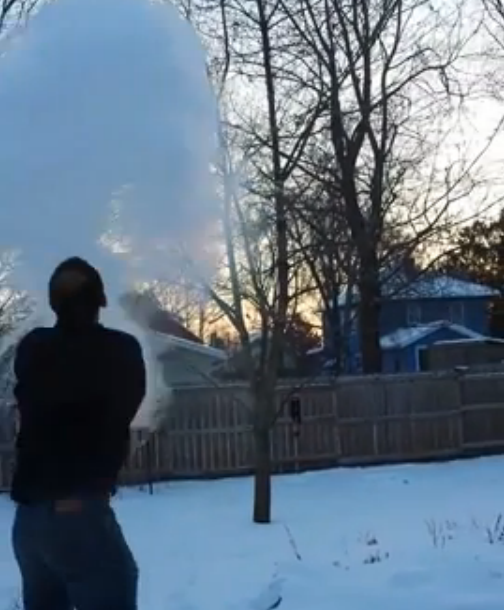Boiling Water Turns Into Snow in Subzero Temps a Hoax
Another science hoax is sweeping the country, it seems. As two-thirds of the country is gripped in the clutches of a Polar Vortex, many are spending time outside in the cold trying to create instant snow.
Internet videos and stories are telling people to head outdoors in the subzero temps with a pot of boiling water. They claim when you throw the hot water into the freezing air, the result will be instant snowfall.
We hate to burst your frozen bubbles everyone, but this is a hoax. When you throw hot water into cold air, you do get a cool reaction of water vapor and condensation, but you don’t get snowflakes. Only some of the hot water will condensate, but most of it will fall back down to the ground. Many people have been burned after throwing hot water above their head and having it fall down on top of them.
If you want to try this on a safer, smaller scale, you will get the same result from placing a steaming cup of hot coffee in the freezer.
While the reaction of throwing the hot water into the cold air is pretty dramatic, it isn’t creating snowfall. Snowflakes are created when a water droplet attaches to a piece of dirt or dust in a cloud. The hot water droplets don’t have time to attach to anything before they fall back to earth.
If you are in the areas with extreme cold and want to use your scientific skills to experiment and learn, here are a few safe experiments to try. And remember, don’t stay outside very long. It doesn’t take a lot of time for skin to freeze or frostbite to set in. Go out in small bursts and get back where it’s warm.






Steve, I must respectfully disagree. I’ve done this myself, and it worked. True, I didn’t get snowflakes, but I did get a big puff of condensation, a weird crackling sound as the water froze, and mostly ice crystals/pellets that fell back down. All the water froze before it hit the ground. I was in northern Canada, and the outside temperature was about -30 C when I tried it. I didn’t have boiling water, just hot tap water. I used a plastic water pitcher and threw about a liter of water into the air. If you used a large bucket, I guess that would probably fail.
Thanks Alan2236 – We aren’t arguing that the result isn’t cool, just that it isn’t real snow. We are also trying to discourage people from trying this at home, as so many are getting burned. Hot tap water in -30 C air could definitely freeze before hitting the ground, based on the temp of the water and the air along with how high it is thrown. It’s much better to use hot water instead of boiling and throw it away from yourself instead of overhead. Thanks for your comments. We do appreciate them (especially the ones that question and make people think!)
That’s awesome!!!!
That is so cool! My son could make a Science Fair Project out of it. I’m going to tell him about it.
I have also tried this experiment and found that, with the exception of trying it at -20F, most of the hot water fell to the ground as water…. it then froze. The -20F temp was very interesting because much of the water froze hitting the ground. In any case, not much in the way of snow. However, just like with snow machines, it is possible to make “snow” at temperature up to 35F. This type of snow is not like natural snow though. Under a microscope, the structures are jagged and irregular. Very different from natural snow. (The skiers report there is a huge difference in skiing properties.) Also, technically, we don’t call the transition from liquid (in the form of mist droplets)to ice a reaction since it is just a change of physical state. The interesting thing is that much of the mist will become super-cooled and only freezes upon contact with a frozen surface. (This is the situation with freezing fog.) I also suspect that some of the super-cooled mist will find a nucleation source and form icy “snow” before hitting the ground or sublimating to gaseous water.
Thank you so much for posting this information on your website! I teach science to fifth graders and some of them had seen this video. My local news station had reported on people being badly burned attempting this ridculous experiment. I am so glad that none of my students were victims…
So….It’s not really a HOAX, its just a misunderstanding. So, dramatic!
How do people get clingy thingies if they make it to the locations where they are being given away?
Hi Sherry – the clings are from 9News. You can contact them for more information. http://www.9news.com/
We know what we get (you negitive ninny) and it’s still fun:)